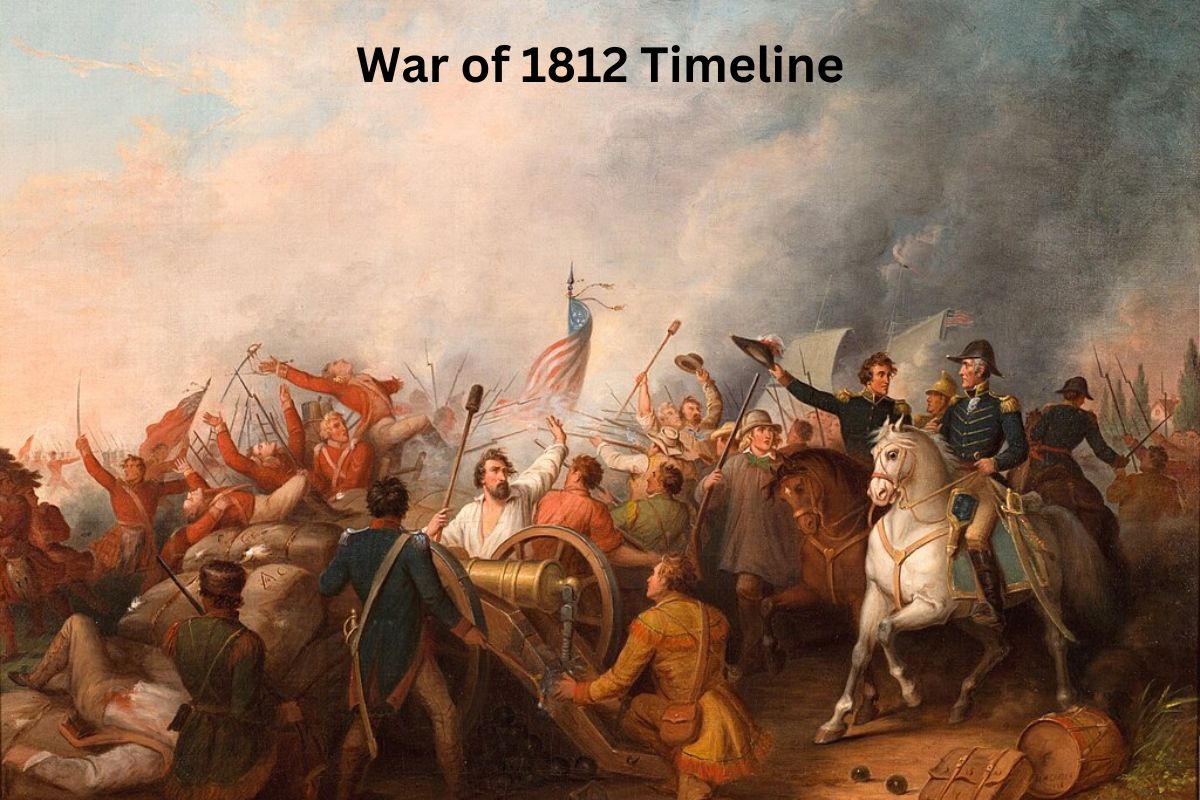The War of 1812, which took place between 1812 and 1815, was a significant conflict between the United States and the British Empire, including British Canada and various Native American tribes.
This war arose from a complex web of issues, including British impressment of American sailors, trade disputes, Native American conflicts, and American expansionist ambitions.
The war witnessed a series of battles, naval engagements, and notable events that had a profound impact on American identity, diplomacy, and territorial boundaries.
In this historical overview, we will explore key events and turning points during the War of 1812, shedding light on the factors that led to the conflict and its far-reaching consequences.
| Year | Event |
|---|---|
| 1803-1812 | Rising Tensions |
| June 18, 1812 | War Declared |
| 1812 | Early Battles |
| August 19, 1812 | USS Constitution vs. HMS Guerriere |
| 1813 | Naval Conflicts and Burning of Washington |
| September 10, 1813 | Battle of Lake Erie |
| October 5, 1813 | Battle of the Thames |
| 1814 | British Blockade and Raiding |
| August 24-25, 1814 | Battle of Bladensburg |
| September 13-14, 1814 | Battle of Baltimore |
| December 24, 1814 | Treaty of Ghent |
| January 8, 1815 | Battle of New Orleans |
| February 18, 1815 | Ratification of the Treaty of Ghent |
Timeline of the War of 1812
1803-1812: Rising Tensions
During this period, several factors contributed to the rising tensions between the United States and the British Empire, ultimately leading to the War of 1812:
Impressment of American Sailors: One of the major grievances was the British practice of impressing American sailors into service on British ships. British naval officers often claimed that American sailors who had previously served in the Royal Navy were still British subjects and could be forcibly impressed back into service. This was a significant point of contention for the United States, as it violated American sovereignty.
Interference with American Trade: The British also interfered with American trade, particularly in the context of the ongoing Napoleonic Wars. They imposed trade restrictions, including blockades and embargoes, which hurt American merchants and traders. The Orders in Council issued by the British government restricted American trade with France and its allies.

Native American Conflicts: In the Northwest Territory, tensions between American settlers and Native American tribes, often supported by British agents, were escalating. The Shawnee leader Tecumseh and his brother, Tenskwatawa (known as the Prophet), sought to unite Native American tribes against American expansion, leading to the Battle of Tippecanoe in 1811.
Expansionist Ambitions: Some American expansionists, often referred to as War Hawks, were eager to acquire more territory, particularly in British-held Canada. They saw the war as an opportunity to achieve this goal and gain control of strategic land and resources.
Nationalism and Honor: There was also a growing sense of American nationalism during this time. Many Americans felt that their national honor was at stake due to British actions, including the impressment of American sailors and interference with trade. This sense of national pride played a role in the decision to go to war.
War Fever: Public sentiment in some regions, particularly in the South and West, was in favor of war with Britain. This sentiment was driven by various factors, including economic interests, perceived British provocations, and a desire to assert American sovereignty.
June 18, 1812: War Declared
On June 18, 1812, the United States officially declared war on the British Empire.
This declaration marked the beginning of the War of 1812, a significant conflict that arose from a range of issues, including British impressment of American sailors, trade disputes, Native American conflicts in the Northwest, and American territorial expansion aspirations.
The war had lasting impacts on American national identity and diplomacy and played a role in the development of the young nation.
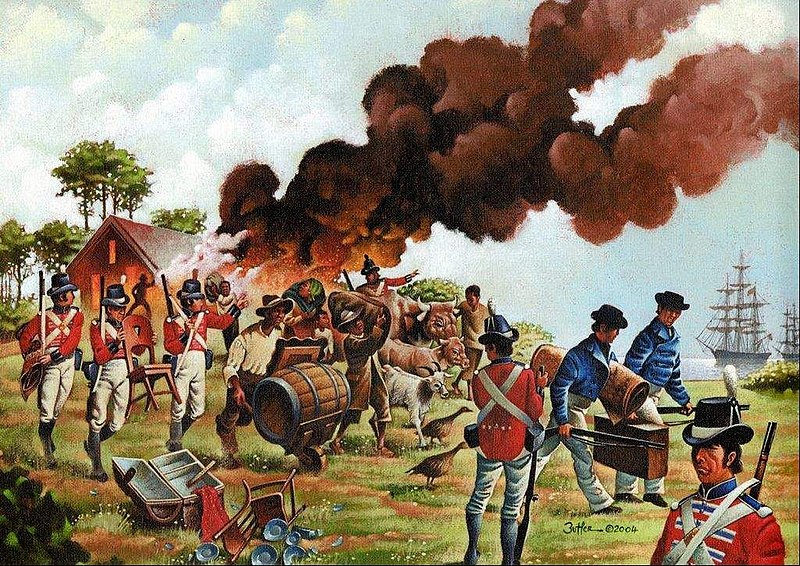
1812: Early Battles
In 1812, the early stages of the War of 1812 saw several key battles along the Canadian border. These battles were part of the broader conflict between the United States and the British Empire, including British Canada. Here are some of the notable early battles in 1812:
- Siege of Detroit (July 1812): American forces, led by General William Hull, attempted to invade Upper Canada (now Ontario) but were besieged by British and Native American forces under Major General Isaac Brock. Hull eventually surrendered Detroit without significant resistance, a significant early setback for the United States.
- Battle of Queenston Heights (October 1812): American forces, under General Stephen Van Rensselaer, attempted to capture Queenston, a village in Upper Canada. British and Canadian forces, led by Major General Isaac Brock, repelled the American invasion. Brock was killed in action, but the British and their allies held their ground.
- Battle of Frenchtown (River Raisin) (January 1813): American forces, led by General James Winchester, clashed with British and Native American forces in Frenchtown, Michigan (also known as River Raisin). After initial American success, they were defeated in a subsequent engagement. The battle resulted in the killing of many American prisoners, leading to the phrase “Remember the Raisin” becoming a rallying cry for American forces later in the war.
These early battles in 1812 and early 1813 were characterized by mixed outcomes and set the stage for further conflict and shifting territorial control along the Canadian border during the War of 1812.
August 19, 1812: USS Constitution vs. HMS Guerriere
The USS Constitution, a United States Navy frigate, achieved a significant victory over the British frigate HMS Guerriere in a naval battle off the coast of Nova Scotia.
This engagement was a morale booster for the United States, as the Constitution’s superior firepower and solid oak hull earned it the nickname “Old Ironsides.” The battle demonstrated the capability of American naval forces and helped boost American morale early in the war.
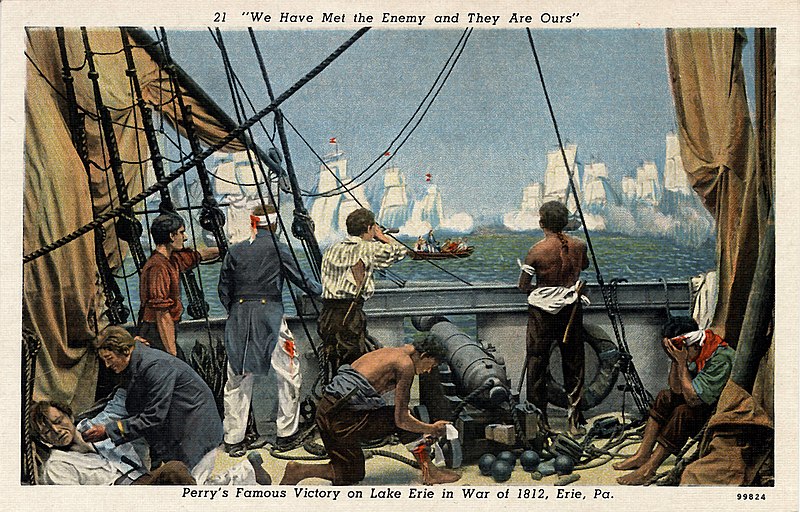
1813: Naval Conflicts and Burning of Washington
In 1813, the U.S. Navy continued to engage British naval forces on the Great Lakes and the high seas. Notable naval battles included the Battle of Lake Erie in September, where Commodore Oliver Hazard Perry’s victory secured control of Lake Erie for the Americans. This allowed for an American invasion of Canada.
In August 1814, British forces, including troops commanded by General Robert Ross, advanced into the Chesapeake Bay area. They captured and subsequently burned Washington, D.C., including the White House and the Capitol.
The burning of the nation’s capital was a significant blow to American prestige, but it did not lead to a British victory in the overall war.
September 10, 1813: Battle of Lake Erie
The Battle of Lake Erie on September 10, 1813, during the War of 1812, was a pivotal naval clash that occurred on Lake Erie. It was a crucial moment in the struggle for control of the Great Lakes between the United States and Great Britain.
Under the leadership of Commodore Oliver Hazard Perry, the American fleet engaged the British squadron. After a fierce battle, Perry’s forces emerged victorious, securing control of Lake Erie.
This victory disrupted British supply lines, boosted American morale, and played a key role in subsequent military operations in the western theater of the war.
October 5, 1813: Battle of the Thames
The Battle of the Thames, fought in southwestern Ontario, Canada, was a pivotal land battle in the war. American forces, commanded by General William Henry Harrison, defeated British and Native American forces.
The most notable casualty was the Shawnee leader Tecumseh, who was killed in action. Tecumseh’s death weakened Native American resistance in the Northwest, and this battle marked a turning point in the war in the western theater.
General Harrison’s victory at the Thames and the death of Tecumseh dealt a significant blow to the British alliance with Native American tribes in the region. It also secured American control over parts of the Northwest Territory, further influencing the outcome of the war.
1814: British Blockade and Raiding
British Blockade: In 1814, British forces implemented a blockade along the American coastline. This blockade aimed to disrupt American trade, strangle the U.S. economy, and put pressure on the American government to negotiate a favorable peace settlement. The blockade had a significant impact on American commerce and contributed to economic hardships.
Raiding: In addition to the blockade, British forces conducted raids along the American coast. One notable example was the Raid on Washington, D.C., in August 1814. Following their victory at the Battle of Bladensburg, British troops under General Robert Ross entered the American capital and burned several government buildings, including the White House and the Capitol. The burning of Washington was a symbol of British military success during the war.
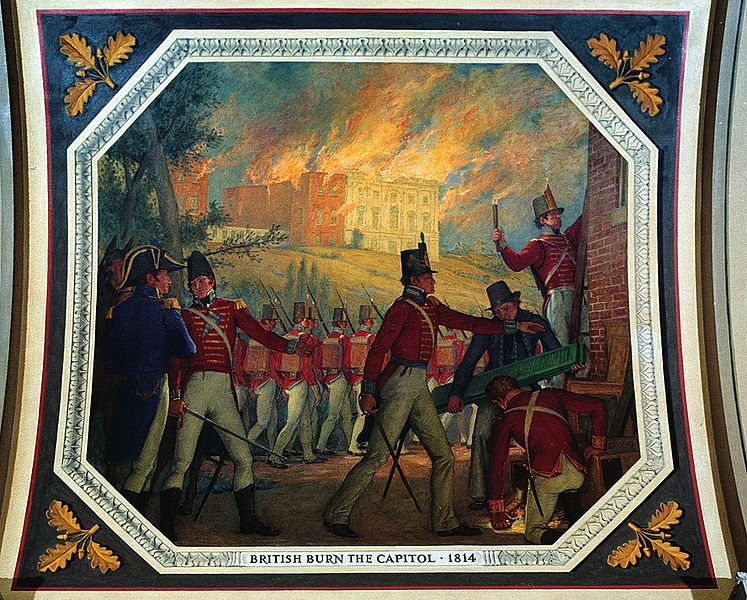
August 24-25, 1814: Battle of Bladensburg
The Battle of Bladensburg was a land battle that took place just outside Washington, D.C. American forces, including militia units, attempted to defend the capital against a British advance.
However, they were quickly defeated by the better-trained and more experienced British troops. The American defeat at Bladensburg allowed the British to enter and subsequently burn Washington, D.C.
The battle revealed the inadequacies of the American military at that time, as many militia units fled in the face of the British advance. It also highlighted the need for better organization and training of American forces.
September 13-14, 1814: Battle of Baltimore
The Battle of Baltimore was a significant engagement that took place in and around the city of Baltimore, Maryland. American forces, including militia and regular troops, defended the city against a British naval and ground assault. The British intended to capture Baltimore as part of their campaign in the Chesapeake Bay area.
Fort McHenry, guarding the entrance to Baltimore’s harbor, played a central role in the defense. During the battle, the fort withstood a bombardment by British ships. Francis Scott Key, who witnessed the battle from a British prison ship, was inspired to write “The Star-Spangled Banner,” which later became the U.S. national anthem.
American forces successfully defended Baltimore, and the British withdrew. This victory boosted American morale and demonstrated the resilience of American forces in the face of a determined enemy.
December 24, 1814: Treaty of Ghent
The Treaty of Ghent, signed in Belgium on December 24, 1814, effectively ended the War of 1812. Negotiations had been ongoing for several months, and the treaty was ratified by both the United States and Britain in early 1815.
The treaty restored pre-war borders, essentially returning both sides to the status quo before the conflict. It did not address many of the issues that had led to the war in the first place, such as impressment and trade restrictions, but it did bring an end to the fighting.
One significant aspect of the treaty was that it did not change the maritime status quo, which was important for American interests as the Napoleonic Wars in Europe were also coming to an end.
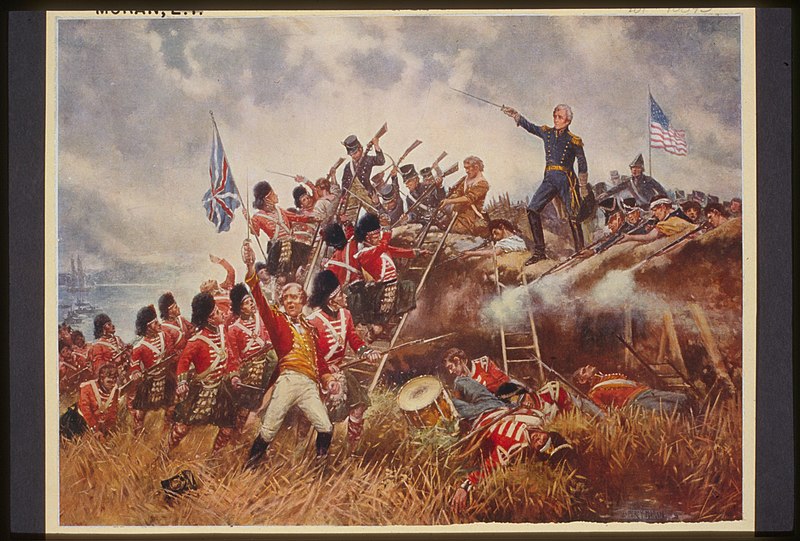
January 8, 1815: Battle of New Orleans
The Battle of New Orleans was one of the final major engagements of the War of 1812 and took place near New Orleans, Louisiana.
British forces, under the command of General Edward Pakenham, launched an assault on American positions, which were defended by a diverse mix of American troops, including regular soldiers, militiamen, and local volunteers.
The battle resulted in a resounding American victory. Despite being outnumbered, American forces, led by General Andrew Jackson, successfully repelled the British attack. The British suffered heavy casualties, including the loss of General Pakenham. In contrast, American casualties were relatively low.
The Battle of New Orleans had a significant impact on American morale and became a source of national pride. It was fought after the Treaty of Ghent had been signed but before news of the treaty’s ratification had reached the combatants. As such, it did not affect the outcome of the war but further solidified American patriotism and was seen as a symbol of American resilience.
February 18, 1815: Ratification of the Treaty of Ghent
The Treaty of Ghent, which had been signed in Belgium on December 24, 1814, was ratified by both the United States and Britain on February 18, 1815. The ratification process marked the official end of the War of 1812.
The treaty restored pre-war borders and effectively ended the hostilities between the two nations. It did not address many of the specific grievances that had led to the war, such as impressment and trade restrictions, but it did bring a halt to the fighting.
Notably, the news of the treaty’s ratification did not reach the combatants until after the Battle of New Orleans had taken place. This means that the battle itself occurred after the war was officially over, making it a somewhat inconsequential engagement in terms of the war’s outcome.
The Treaty of Ghent set the stage for a return to peaceful relations between the United States and Britain. Despite the inconclusive nature of the war and the lack of significant territorial changes, it had important implications for American national identity and the growth of industry and trade in the United States.
